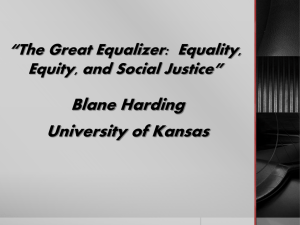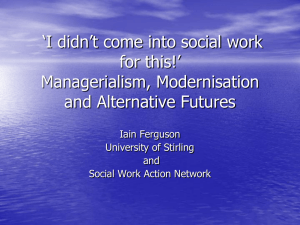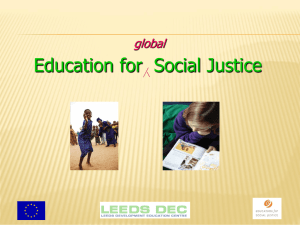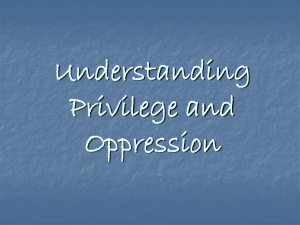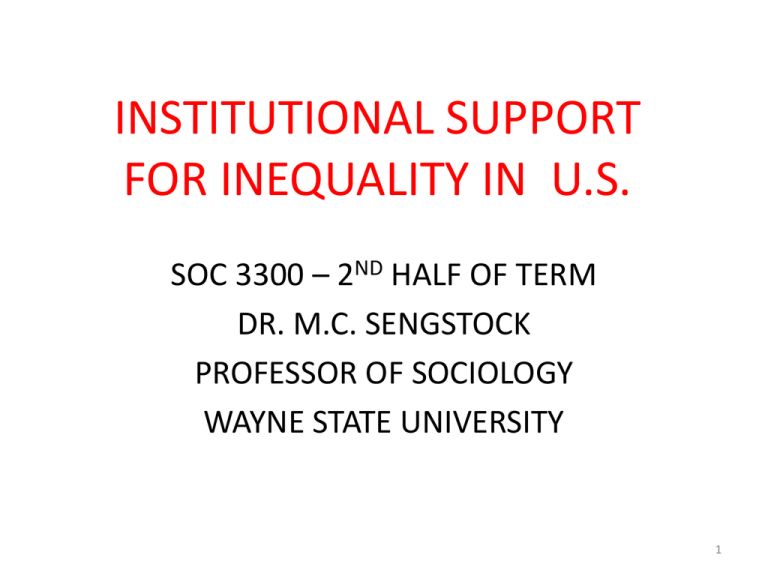
INSTITUTIONAL SUPPORT
FOR INEQUALITY IN U.S.
SOC 3300 – 2ND HALF OF TERM
DR. M.C. SENGSTOCK
PROFESSOR OF SOCIOLOGY
WAYNE STATE UNIVERSITY
1
SUMMARY THUS FAR
• Focus on Nature & Types of Inequality
• History of Inequality:
– General
– U.S. Dimensions
• Some Introductory Causal Issues
• Brief Introduction to Institutional Dimensions
2
2ND HALF OF TERM
•
•
•
•
Focus Primarily on American Institutions
Meaning of “Institutions” in Societies
Types of Institutions in American Society
Means By Which Institutions Relate to Inequality:
– Help Establish Inequalities
– Reinforce Existing Social Statuses
– Reinforce Existing Inequalities
Source: Part II, Intro:
“Maintaining Inequalities: Systems of Oppression & Privilege”
3
WHAT IS AN INSTITUTION?
• Social Structure Governing Action of
Individuals within a Specific Sphere of Activity
• Widespread Throughout Society
• Does NOT Refer to a Specific Group or
Organization
• I.e., “Bank of America” is NOT an “Institution”
• The Structure of “Banking” in American IS an
“Institution”
4
TYPICAL SOCIAL INSTITUTIONS
IN NEARLY ALL SOCIETIES
• FAMILY: Structure of Persons with Biological
(or Perceived Biological) Relationships
• RELIGION: Structure of Beliefs and Relation to
“The Unknown”
• ECONOMY: Structure of Means by Which
Members of a Society Make a Living
• POLITICAL: Structure by Which Society Is
Governed
5
INSTITUTIONS IN
MODERN SOCIETIES
• FAMILY – RELIGION – ECONOMY – POLITICAL
• BUT: Many Other Components Have Also
Become “Institutionalized” -- EX:
• Teaching Children – Formerly Task of FAMILY
• Absorbed by EDUCATIONAL Institution
• Leads to NEW INSTITUTIONS:
– EDUCATION; MEDIA; HEALTH; even “RECREATION”
6
OTHER SOURCES OF
NEW INSTITUTIONS
• Various TYPES or COMPONENTS of Religion,
Economic, Political Structures, Organized as
Separate INSTITUTIONS
• EX: ECONOMY BANKING; AGRICULTURE;
MANUFACTURING; RETAIL; FOOD SERVICE
• POLITICS GOVERNMENT; LAW; PRISONS;
COURTS
• RELIGION INDIVIDUAL “RELIGIONS”
7
SUMMARY: INSTITUTIONS
•
•
•
•
•
An INSTITUTION Is NOT an “Organization”
An INSTITUTION IS:
A Specific Way of Organizing Human Behavior
In a Specific Sphere of Activity
Providing a Structure of Values, Values,
Beliefs, Rules for Behavior
• In That Particular Area of Social Life
8
HOW DO INSTITUTIONS
“STRUCTURE” INEQUALITY?
• INTRODUCTORY EXAMPLES:
• Airplane Handling of Arabs, Muslims
– 6 Imams – Minneapolis Flight: Suspicious Praying
– Kareem Alasady (U.S. citizen): Pilot Refused to Fly
• Traffic Stops of “People of Color”
– Atty Robt Wilkins & Family – Stopped by MD
Police Instructed to Search for Drugs
– IL Test of Stops Police Stopped Investigator Chavez
9
TERMINOLOGY
• PRETEXT STOPS: Use of Alleged Traffic “Violations”
As “Pretext” to Stop Motorists
• RACIAL PROFILING: Practice of Stopping People of
Color for Questioning
• Assumption: They Are More Likely to Be Engaged in
Criminal Activity
• NEARLY ALL People of Color Have Experienced This
• SUBURBAN Areas Particularly Common – AfricanAmericans 300% More Likely to Be Stopped
(Southern Poverty Law Center Research Studies)
10
DEFINING INDIVIDUALS BY STATUS
• Status: Socially Defined Positions People Hold
in Society (Parent, Lawyer, Jew, Italian, etc.)
• “Profiling” Focuses on a SINGLE STATUS
• “MASTER STATUS”: Status Society Considers
MOST IMPORTANT
• RACIAL (Ethnic, etc.) Is Often Considered Most
Important By Social Leaders, Power Groups
• Master Status “Trumps” All Others!
11
STATUSES AS
CATEGORIES OF DIFFERENCE
• Purpose: Perpetuate the Past
• Privilege: Rights & Assets That Accompany
Statuses
– Some Earned – E.g., College Degrees
– Others Unearned – White, Black, Country Clubs
• Oppression: Domination or Submission
– Perpetuate Statuses – Upper & Lower
– Maintain the Existing Stratification System
12
TYPES OF OPPRESSION
• Institutionalized Oppression:
– Built Into & Supported by Institutions
– Institutions (Family, Education, Courts) Maintain
Oppression (EX: Pretext Stops; “Legacy” Admissions)
• Interpersonal Oppression
– Manifested Between Individuals (Insults, Demeaning
Action to Member of Another Race, Religion, Gender)
• Internalized Oppression
– Directed at Oneself – One Accepts Subordinate Status
– Targeted Person Feels Demeaned, Offended, Insulted
13
ROLE OF IDEOLOGY IN ESTABLISHING
& MAINTAINING INEQUALITY
• IDEOLOGY: Set of Cultural Patterns That Form a
Basis for Inequality
• Justify Interests of Dominant Group
• VALUES: Define What/Who Is Important
• BELIEFS: State What Is “True” About Groups
– Upper Class is Smarter; Lower Less Capable
• ATTITUDES: Describe Appropriate Feelings
– Southern Instruction to Child: “’Lady’ Is Applied to
Some White Women; Never to Black Women.”
14
EXAMPLES OF
OPPRESSION IDEOLOGIES
• Androcentrism: Maintains Theory That Men Are
Superior to Women Preserves Sex/Gender System
• Capitalistic Ideology: Preserves View That:
• Profits Are Primary; Workers Are Less Valuable; Justifiable
to Pay Them Less Than Others
• Oppression Involves: Systematic Barriers to Maintain
Certain People in a Subordinate Status (Frye, 1983)
• Birdcage Analogy: Use of Numerous, Tiny, Unnoticed
Barriers (Wires) – Not Recognized As Interconnected
Network Unless Viewed from a Macro Perspective
15
DEFINING FORMS OF OPPRESSION
• Prejudice: Negative Attitude Toward
Members of a Group or Category
• Discrimination: Unequal Treatment Directed
Against People Based on Group Membership
• Institutionalized Racism: Systematic Policy or
Practice of Exploiting or Controlling People
Because of Perceived Physical Characteristics
• EX: Use of Native American Symbols as Sports
Mascots (Stanley Eitzen)
16
“CLASSISM”:
SOCIAL CLASS OPPRESSION
• Use of Government Economic Policies to Benefit
Upper vs. Middle & Lower Classes
–
–
–
–
Top 20% of U.S. Households 70% of Income
Bottom 20% 3.4% of Income
Top 20% of Population Owns 85% of Wealth
Bottom 80% Owns 15% of Wealth
• Tax Breaks: Wealthiest 1%: 53% of Tax Breaks
– Taxes Gradually Shifted From Investment to Wages
• Wealthy Person’s Dividends: 15% Tax Rate
• School Teacher ($28,000): 45% Tax Rate
17
Proposed “9-9-9” Tax Reform Plan
Increased/Decreased Tax Liability
Bot 20%
2nd 20%
Mid 20% 4th 20%
Top 20%
Top 1%
Top 0.1%
+$1,854
+$3,898
+$4,330
-$14.4K
-$238K
-$2.3M
I
I
I
-$20K
I
I
---
I
I
-$235K
I
I
+$10K
-$10K
+$4,299
-----
I
-$1.35K
I
Derek Thompson, The Atlantic
http://www.theatlantic.com/business/archive/2011/10/rick-perrys
-tax-cut-for-the-rich-in-a-very-very-tall-graph/247635
18
SEXISM & INSTITUTIONALIZED
EXPLOITATION BASED ON GENDER
• Systematic Discrimination Against Women in
Employment:
– Height or Attractiveness in Certain Jobs (Police Work;
Weight or Body Type in Casinos, “Hooters”)
• Job Discrimination Against Homosexuals
• Does NOT Require a Male Heterosexual to
Actually Behave in a Sexist Manner to Profit!
• Straight Males Gain an Advantage Simply By
Virtue of the Preference for Straight Males
– There Are More Positions Open to Them Than Others!
19
UNCONSCIOUS & INTERCONNECTED
IMPACT OF INSTITUTIONS
• Institutionalized Patterns Are Viewed as “Just the
Way Things Are” – Unquestioned
• Interconnected Institutions Assist in Process:
•
•
•
•
•
“Redlining “in Housing Covenants
Policies of Mortgage Brokers
Racial “Steering” of Real Estate Agents
Geographically Based School Districts
Geographical Location of Places of Employment
• Collectively Maintain Separate Races, Classes
• Ensure Each Gets “Appropriate” Life Chances
20
INTERRELATING INSTITUTIONS
TO BE CONSIDERED
FAMILY
EDUCATION
ECONOMY & WORK
STATE & PUBLIC POLICY
MEDIA
LANGUAGE
RELIGION
VIOLENCE & PUBLIC POLICY
21
INTERRELATING INSTITUTIONS
TO BE CONSIDERED (No. 1)
• Family
(Rubin, #17; Stacey, #19):
– Decreasing Wages 2 Parent Family; Child Care Costs
– Definitions & Policies: “Family Values” (Gay Families)
• Education:
–
–
–
–
(Kahlenberg, #20; Dog & Erdoes, #21; Sadkers, #22; Miceli, #23):
Cultural Capital Differential School Experiences
Hidden Curriculum Minorities Physical Discipline
Hidden Curriculum Girls Learn Submissiveness
Hidden Curriculum No “Aid” for Homosexuality
“Heternormativity” Reinforces Heterosexuality
22
INTERRELATING INSTITUTIONS
TO BE CONSIDERED (No. 2)
• Economy & Work (Wilson, #24 Pager et al, #25; Wilson, #24):
– Unavailability of Employment in Ghettos
– White Applicants Favored in Employment
(Individuals Need NOT Discriminate to Benefit!)
– Policies Maintain Substantial Wage Gender Gap
• State & Public Policy (Burnbaum, #28; Western & Pettit, #29;
Wessler, #30):
– Child Welfare Policies Perpetuate Inequality of
Minority, Female-Headed Families
– Criminal Justice System Reinforces Inequality in
Prosecution & Punishment
23
INTERRELATING INSTITUTIONS
TO BE CONSIDERED (No. 3)
• Media (#31 - #34):
– Sitcom Devaluing of Women, Working Class Men
– Enhancing the “Wisdom” of Middle Class Parents
– Few & Inaccurate Images of Varied Sex Categories
• Language: Defines Our World: Gender (#35-37):
– Fireman, Mankind, Manpower, Generic “he,” etc.
– Women Defined in Relation to Men (Miss, Mrs.)
– Trivialization of the Feminine: Stewardess; Lady
Lawyer; Lady Doctor
Language Defines Our World!
24
INTERRELATING INSTITUTIONS
TO BE CONSIDERED (No. 4)
• Religion: Provides an Example – & Rules – For Perpetuating
Inequality
• Women Subordinate in Nearly All Religious Groups, Traditions
• Races Have Been Viewed as Subordinate in Many Religious Traditions
• Violence & Social Control Institutions:
• Violence Often Used As Social Control Mechanism
Law, #38; Armstrong, et al, #39; Kaufman, #40;):
(S Poverty
• “Beaner Hopping” – Teens Seek Hispanics to Beat Up (Prev. Ed.)
• Campus “Rape Culture”: Fear to Keep Women in Control
• Using Violence to Construct Masculinity to Perpetuate Subordination
of Others Perpetuate White Male Dominance
• School Bullying; Cyberbulling (Schneider, et al., #41)
25
SUMMARY
•
•
•
•
•
•
•
Remainder of Course:
Focus on INSTITUTIONAL Basis of Inequality
Through Analysis of U.S. Institutions
The Manner in Which They Work Together …
To Perpetuate Inequality … and
The Existing Stratification Structure …
Making Systemic Change Nearly Impossible!
26
Social Change Pyramid
How Long Will It Take?
Control
Who Is Most
Likely to Change?
Who Is Likely to
Resist Change?
Leaders
50+
Aspiring Leaders
What Is the Chance
Of Change Occurring?
Why?
Maintain Control
25-49
Children, Youth
Most Likely Changers
<25
27
Social Change Pyramid
Interrelating Institutions
Control
Leaders
50+
Aspiring Leaders
STATE
Maintain Control MEDIA
ECONOMY
25-49
Children, Youth
SOCIAL CONTROL
RELIGION
LANGUAGE
Most Likely Changers
FAMILY
<25
EDUCATION
28




